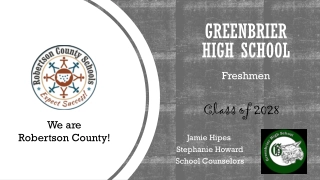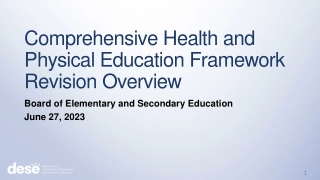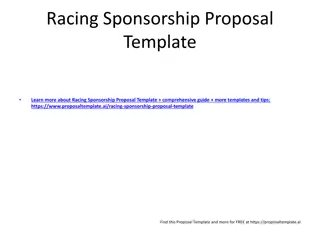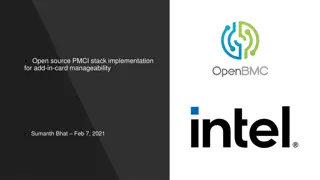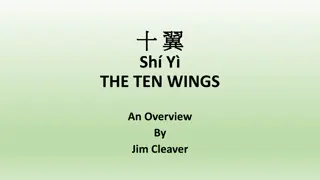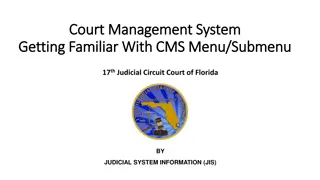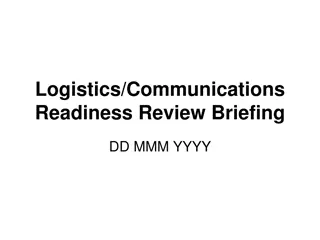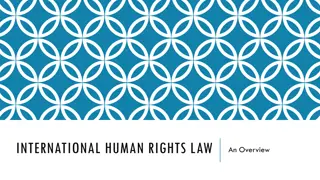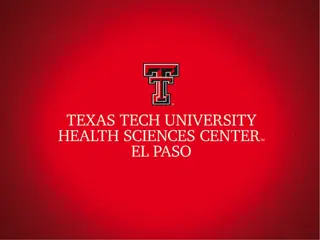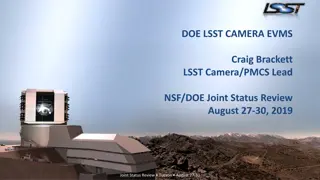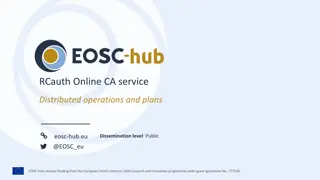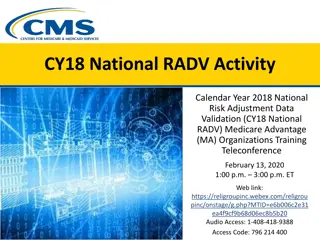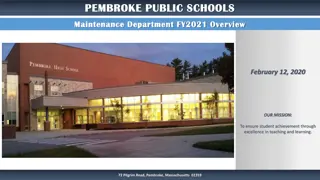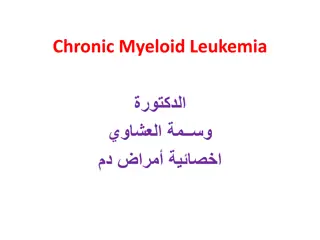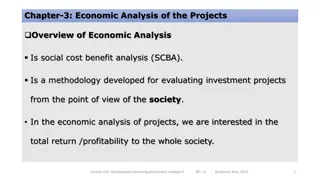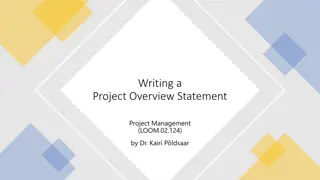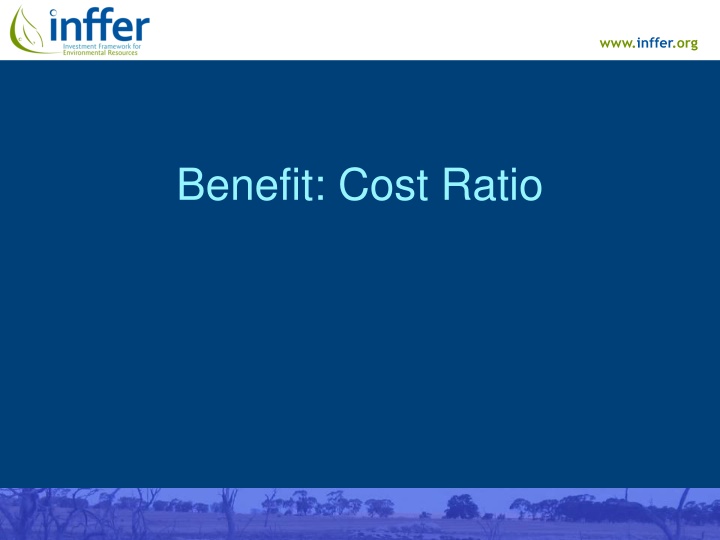
Environmental Project Value Maximization Strategy
Learn how to determine if a project is worthwhile based on the benefit-to-cost ratio. Discover the importance of measuring benefits consistently and utilizing the best available data for decision-making. Explore the INFFER metric for quantifying environmental benefits efficiently.
Download Presentation

Please find below an Image/Link to download the presentation.
The content on the website is provided AS IS for your information and personal use only. It may not be sold, licensed, or shared on other websites without obtaining consent from the author. If you encounter any issues during the download, it is possible that the publisher has removed the file from their server.
You are allowed to download the files provided on this website for personal or commercial use, subject to the condition that they are used lawfully. All files are the property of their respective owners.
The content on the website is provided AS IS for your information and personal use only. It may not be sold, licensed, or shared on other websites without obtaining consent from the author.
E N D
Presentation Transcript
www.inffer.org Benefit: Cost Ratio
Is the project worth doing? How to judge? Assume aim is to maximise the value of environmental outcomes Value can include Environmental, social and economic Tangible and intangible www.inffer.org
Resources are limited Not every good project can be funded Best strategy is to choose highest ratio of benefits to costs Dividing by costs is crucial Reveals projects that give best value for money (benefits per dollar spent) Works even if projects are of different sizes www.inffer.org
Measuring benefits For ranking to work, benefits need to be measured in a consistent way Not necessarily in dollars Our approach is to define a scoring system and apply it consistently www.inffer.org
VW V: asset value W: effectiveness of works A B A: adoption B: compliance F P G F: feasibility P: socio-political G: long-term funding 1/(1 + r)L L: time lag to benefits r: discount rate Potential project benefits Discount factor for time lags E(prop n of required adoption) (1 Risk of ) failure BCR = Project cost C + PV(M+E) G C: project cost M: annual maintenance cost E: polluter-pays compliance costs PV: summed present value over 20 years G: long-term funding www.inffer.org
Simulations of other metrics In terms of expected value of environmental benefits, the INFFER metric is about 100% better than commonly used metrics Some add where they should multiply Many ignore costs Most omit one or more of the benefits factors (often feasibility and adoption) www.inffer.org
Data quality Process uses best available data and knowledge Can be based on expert opinion if necessary Can update with improved science or modelling if it becomes available Step 3 elicits quality of information data gaps strategy to deal with data gaps www.inffer.org
The asset and spin-offs INFFER quantifies benefits that are directly related to the natural asset Other benefits (e.g. increased social capital from doing the project) can be captured qualitatively and reported in Project Assessment Report The asset can be defined more broadly to capture 2 or more sub-assets www.inffer.org
Simplification The current version of INFFER asks for only one response for each parameter In reality, there might be heterogeneity within the asset High feasibility to protect one part Low feasibility for another part Response should be an overall average The price of simplicity 0.7 0.6 0.5 0.4 0.3 0.2 0.1 0 Average www.inffer.org Heterogeneous asset
Simplification Assumes overall benefits are proportional to level of adoption or compliance Might be non-linear Usually too little info to know 10 9 8 7 6 Benefit 5 4 3 2 1 0 0 2 4 6 8 10 Adoption www.inffer.org
Information analysis How do you use the information to make decisions (e.g. scoring/assessment processes)? What works well? What doesn t? www.inffer.org
Improving the current approach Imagine we could design a better approach What would it look like? www.inffer.org
www.inffer.org How is it used?
How is it used? Quantitative data is collected by completion of the Project Assessment Form (PAF) Qualitative information provides context and helps select quantitative values PAF is completed for multiple assets Projects ranked on the basis of BCR www.inffer.org
How is it used? Would not expect mechanistic application of this ranking Priorities also influenced by funder priorities, opportunities, quality of information, Project BCR Rank Lake X 5 1 River Y 1.5 3 Park Z 2.2 2 www.inffer.org
Can also compare versions of the same project Different scales Different on-ground actions Different policy mechanisms Example: Gippsland Lakes www.inffer.org
www.inffer.org Frequently Asked Questions
How does INFFER compare projects for different types of assets? On basis of overall value for money The V score is not specific to a particular type of asset The other elements of the benefit ratio are all proportions or probabilities Allows consistent comparison across asset types www.inffer.org
V seems subjective. Is that a problem? It is subjective. Values are. V makes explicit what we already do implicitly transparency Consistency in scoring is important Relate it carefully to table of V examples Have a group that reviews all V scores for consistency V is usually not the most uncertain factor Often W or A www.inffer.org
How important is accuracy of the numbers We rarely have highly accurate numbers It matters, but great precision is not needed W = 0.1 vs W = 0.8 makes a big difference W = 0.11 vs W= 0.13 doesn t Missing out a variable matters a lot The design of the BCR metric matters a lot Data inaccuracy matters a bit www.inffer.org
How does INFFER compare a one-year project with a five-year project? On the basis of overall value for money. We ask, which of the two projects has the greatest environmental benefits per dollar spent? In both cases, we ask for information about the need for ongoing expenditure (beyond the project) and factor that in. www.inffer.org
How does INFFER compare large and small projects? On the basis of overall value for money. We ask, which of the two projects has the greatest environmental benefits per dollar spent? www.inffer.org
How does INFFER deal with projects that require investment over a long time frame? In the Project Assessment Form, we ask for an estimate of ongoing annual maintenance costs, which are factored into the assessment of cost effectiveness. Maintenance costs are converted to a present value using standard discounting methods. www.inffer.org
How does INFFER deal with projects where there is a long time frame until the benefits are generated? It s designed for a project of say 5 years, with benefits over longer time frame. E.g. project may avert degradation that is not expected to happen for decades, or it may take years for current actions to repair an already- degraded asset. We collect information about the likely time lag until benefits. Then, the BCR includes a discount factor. Projects with more immediate benefits get higher weight (other things equal). www.inffer.org
For more details See the BCR page and FAQs at http://www.inffer.org www.inffer.org
Acknowledgements Affiliations of the INFFER team University of Western Australia Department of Primary Industries, Victoria North Central Catchment Management Authority Future Farm Industries CRC Other key funders Australian Research Council (Federation Fellow Program) Department of the Environment, Water, Heritage and the Arts (CERF Program) Department of Sustainability and Environment , Victoria www.inffer.org

![❤[READ]❤ Deep Space Craft: An Overview of Interplanetary Flight (Springer Praxis](/thumb/21511/read-deep-space-craft-an-overview-of-interplanetary-flight-springer-praxis.jpg)

